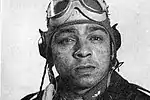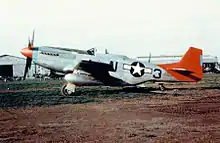Walter Manning
2nd Lieutenant Walter Manning (May 3, 1920 - April 3, 1945) was a member of the famed group of World War II-era African-Americans known as the Tuskegee Airmen. He flew 50 missions, and was awarded the Air Medal for heroism six times. After being shot down in 1945, he was captured in Austria and subsequently lynched by a mob.[3] He was posthumously awarded the Congressional Gold Medal in 2007. Manning is the only known black man to have been lynched in Austria during World War II.[4]
Walter Manning | |
|---|---|
 Walter Manning in 1944 | |
| Birth name | Walter Peyton Manning |
| Born | May 3, 1920 Baltimore City, Maryland |
| Died | April 3, 1945 (aged 24) Austria |
| Plot K, Row 36, Grave 37 | |
| Allegiance | United States |
| Service/ | United States Army Air Force |
| Years of service | 1943-1945 |
| Rank | 2nd Lieutenant |
| Unit | 301st Fighter Squadron |
| Awards |
|
| Relations | Dicey Thomas (Fiancé) |
Military service
World War II

In 1942 Manning was rejected for military service because of a hammer toe. Manning used his savings to pay for surgery to repair his toe so that he could enlist.[1] In 1943 he enlisted in the Army Air Force. in 1944, after graduation, he was assigned to the 301st Fighter Squadron, 332nd fighter Group with the rank of 2nd lieutenant. He served as a pilot from Ramitelli Air Base, Italy.[6]
Dogfight
Manning was involved in a dogfight with Nazi planes on Easter morning, April 1, 1945, over the Danube River. Tuskegee Airmen escorted B-24 bombers on a bombing mission to St. Polten, Austria. On the return trip to their base at Ramitelli Air Field in Italy, the group spotted enemy planes near Wels, Austria. There were seven Tuskegee Airmen flying the mission that day and they engaged the German planes. The Tuskegee Airmen shot down 12 German planes in the dogfight. However three of the Tuskegee Airmen's planes were shot down: one pilot was able to make crash-land in friendly territory, one was killed outright when he was shot down, and the third pilot was Manning: his plane was damaged so badly that he had to bail out. He parachuted into a waiting mob.[1][7][8]
Lynching
On April 3, 1945, Manning was captured and jailed in Austria at a Nazi Luftwaffe Air Force base near Linz. A gang of citizens helped by Luftwaffe officers broke into the jailhouse and tied Manning's hands behind his back. They dragged Manning outside and beat him badly.[9] They hung a wooden tablet around his neck that read "We help ourselves! The Werewolf", and they hanged him from a lamppost.[10][3][7][11]
After the end of war the body of Walter Manning was recovered by US troops. Although they found clear signs of murder US officials closed his case early. Nobody was ever sentenced for the war crime.[4]
Research and commemoration
In 2013 the Austrian historians Nicole-Melanie Goll and Georg Hoffmann carried out a research project together with Jerry Whiting to clarify the fate of Walter Manning.[12][13] As a result of their findings the Austrian Army raised a commemoration plaque at the place where Walter Manning was murdered.[14][15][16]
Awards
- Air Medal for heroism with 5 Oak Leaf Clusters,[1]
- European–African–Middle Eastern Campaign Medal (EAME)
- Purple Heart Medal.
- Congressional Gold Medal (2007) (posthumously)[2]
Education
- Attended Howard University[1]
- Tuskegee Institute (1944)[1]
Personal life
Manning was born in Baltimore, Maryland but grew up in Philadelphia, Pennsylvania. He loved swimming and growing up he always wanted to fly planes. He was engaged to Dicey Thomas before he left for war.[1][7]
See also
- Dogfights (TV series)
- Executive Order 9981
- Fly (2009 play about the 332d Fighter Group)
- Freeman Field Mutiny
- List of Tuskegee Airmen
- Military history of African Americans
- The Tuskegee Airmen (movie)
References
- Newall, Mike (April 20, 2018). "Honors, finally, for a Tuskegee Airman from Philly, lynched by the Nazis". The Philadelphia Inquirer. Retrieved September 27, 2019.
- Guzzo, Paul (November 21, 2016). "Oldest remaining Tuskegee Airman, a St. Petersburg man, dies at 101". Tampa Bay Times. Retrieved September 23, 2019.
- Berger, Tia (May 29, 2018). "Tuskegee Airman Lynched By an Austrian Mob Is Commemorated 73 Years Later". Atlanta Black Star. Retrieved September 27, 2019.
- Hoffmann, Georg (January 1, 2015). Fliegerlynchjustiz: Gewalt gegen abgeschossene alliierte Flugzeugbesatzungen 1943–1945 (in German). Ferdinand Schöningh. pp. 293–297. ISBN 978-3-657-78137-9.
- Rice, Markus. "The Men and Their Airplanes: The Fighters" Tuskegee Airmen, 1 March 2000.
- "2Lt Walter Peyton Manning". Find A Grave. Retrieved September 27, 2019.
- Dwinell, Joe (June 1, 2019). "One of 12 surviving Tuskegee Airmen recounts his 43 WWII combat missions". Boston Herald. Retrieved September 27, 2019.
- Smith, Erica (September 26, 2009). "Lt. Walter P. Manning scores aerial victory". St. Louis Post Dispatch. STL Today. Retrieved September 27, 2019.
- Hoffmann, Georg (January 1, 2015). Fliegerlynchjustiz: Gewalt gegen abgeschossene alliierte Flugzeugbesatzungen 1943–1945 (in German). Ferdinand Schöningh. p. 296. ISBN 978-3-657-78137-9.
- Hoffmann, Georg (January 1, 2015). Fliegerlynchjustiz: Gewalt gegen abgeschossene alliierte Flugzeugbesatzungen 1943–1945 (in German). Ferdinand Schöningh. ISBN 978-3-657-78137-9.
- Patterson, Brandon (May 27, 2018). "Tuskegee Airman honored 73 years after being lynched in Austria". Detroit Free Press. Retrieved September 27, 2019.
- Goll, Nicole-Melanie; Hoffmann, Georg (2016). Missing in Action - Failed to Return (PDF). ISBN 978-3-9504258-0-2.
- "Der Standard: Der Fall Manning: Vom Mob gehängter Afroamerikaner".
- "Memorial for Walter Manning".
- "Research project and commemoration ceremony for Walter Manning".
- "Austrian Database of Downed Allied airmen".
Notes
- The red markings that distinguished the Tuskegee Airmen included red bands on the noses of P-51s as well as a red rudder; their P-51B and D Mustangs flew with similar color schemes, with red propeller spinners, yellow wing bands and all-red tail surfaces.[5]
External links
- Tuskegee Airmen at Tuskegee University
- Tuskegee Airmen Archives at the University of California, Riverside Libraries.
- Tuskegee Airmen, Inc.
- Tuskegee Airmen National Historic Site (U.S. National Park Service)
- Tuskegee Airmen National Museum
- Executive Order 9981
- List of African American Medal of Honor recipients
- Military history of African Americans
